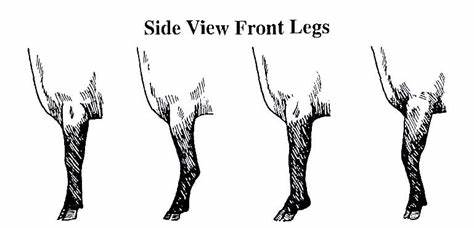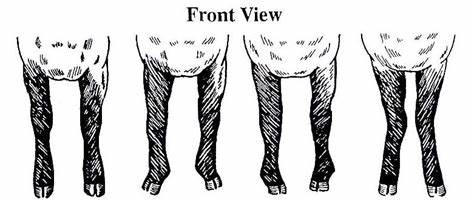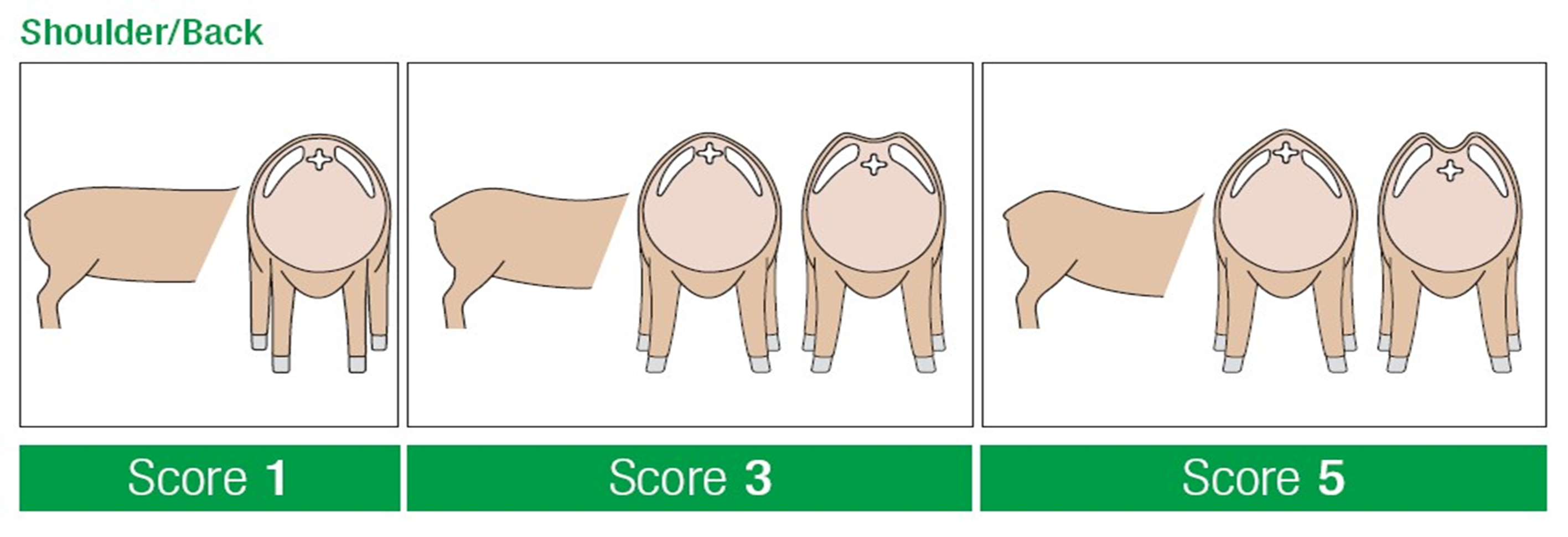- Home
- Persian Sheep
- Sheep Conformation 101
Sheep Conformation 101
It is easy to be distracted by the beauty of the colours and patterns of Persian sheep as well as their charming quiet temperaments. It is important however for breeders to remember the sheep must be structurally sound. The article below was written by Jill Noble and is reproduced here with the permission of the Australian Stud Sheep Breeders Association (ASSBA). The diagrams were part of a slide show cfalled Conformation 101 by Susan Schoenian, the sheep and goat specialist at the University of Maryland. She acknowledged the source as a Facebook group, Daneke Club Lambs. They are reproduced here from Muster May 2023 with the permission of ASSBA.
It is hoped that both the text and images will assist breeders in the selection of stock in their breeding programs.
Sheep Conformation 101
Conformation is the anatomy and skeletal function of a sheep. It impacts the sheep’s health, adaptability, longevity, and productivity. Conformation or structural correctness is made up of the following three aspects:
- The ‘Five Ts’ assessment methodology to visually and mentally summarise an animal or compare groups at a distance before even touching them
- Soundness, structure, balance plus breed traits
- Visual confirmation scoring the animal from 1-5. 1=best 5=worst
The Five Ts
The ‘Five Ts’ assessment methodology to visually and mentally summarise an animal or compare groups at a distance before even touching them.
- Toes - pasterns, fetlock, knees, hocks and leg profile
- Teeth - at lip / mouth profile, jawline
- Testicles - two well balance, noticeable, full and in a firm scrotum.
- Teats - two, well placed with a slight outward tendency attached to a symmetrical udder not always seen in wool sheep but should be noticeable in short wool ewes
- Type - the breed of animal. Knowledge of the unique breed standard features is also required
Soundness
A sheep should be able to move and subsist painlessly, efficiently, and productively throughout its life. The sheep should:
- Be in good condition and healthy (environmental consideration needs to be given here too)
- Have sound feet
- Stand squarely
- Have all body parts in correct position, number, and condition especially the Five Ts as above
Structure
Structure is the way a sheep’s body parts are put together or arranged to form the whole animal.
Structural correctness is important for movement, fertility and longevity. For rams it is crucial for them to be able to mount and impregnate ewes plus potentially passing on genetic traits that maintain or enhance physical structure. For a ewe being structurally correct allows her to get pregnant, carry lambs full term, birth lambs and feed and wean them. Again, with the expectation is that her lambs will maintain or enhance genetic traits like femininity, udder development and teat placement.
Structural correctness includes:
- Growth potential
- Volume/capacity or depth of body
- Condition of the sheep (this is more environmental)
- Legs
- Back
- Neck
- Shoulder
- Eye socket
Balance and Style
Balance in sheep deals with having appropriate portions of:
- Body width
- Body depth
- Body length
Sheep should be wide and deep at the rump and tight and trim through the forequarter with the largest volume of weight in the leg and loin.
Evaluating Balance and Style
Style in sheep deals with:
- Correctness of structure
- Straightness of design
Sheep with good style will have:
- A straight top line
- A neat, smooth shoulder that blends smoothly into the neck and ribs
- Evenness throughout the body
- A strong head applicable to their breed and an alert eye
Balance is often something that you see when you stand back from the sheep or when a sheep stands out in a mob. It is aesthetically pleasing on the eye. In humans this would be referred to as symmetry of features.
Back
Back should be level and strong with no dip behind shoulders. Definitely no weak or splayed/swayed backs.
Score 1= Very good, shoulder blades sit squarely on either side of the spine with no ridge between the shoulders, back straight between shoulders and hips.
Score 2= good
Score 3= Average, shoulders positioned below the spine to create a ridge.
Score 4= poor
Score 5= Extremely high and wide shoulders that create trough above the spine or extremely low and narrow shoulder blades that create a sharp ridge, (Devil’s Grip ) back dips severely behind the shoulders.
‘ Devils Grip ‘ is an insidious genetic fault behind the withers that is the result of a poor mating choice. Often the result of trying to correct a trait rather than cull the animal with the trait deficiency. It was once widespread in the Merino but nature in the form of flystrike eliminated much of it naturally. It is more commonly seen today in developing or small gene pool breeds where extreme muscled or length animals are mated to more refined or shorter animals resulting in a weak shoulder spine connection.
Growth
Many environmental and genetic factors influence growth of an animal. Bone is more dense than muscle and muscle is more dense than fat. All three factors along with the environment contribute to expressions of growth. A traditional visual rule of thumb has suggested that length of cannon bone is accurate to determine growth. Length of cannon bone and then in association with length of body and neck contribute to an early maturing animal. Naturally if an animal has to walk long distances for feed and water a longer cannon bone and bigger ‘growthy’ frame would be more advantageous but would compromise an earlier maturing pattern.
Volume/capacity or depth of body
This means that the sheep has room inside their body for heart, lungs, rumen, etc. This also gives them a solid frame to attach muscle and fat which is an economic requirement for productive animals.
Condition
Condition is more environmental than genetic. It relates to whether a sheep is overly-fat, overly-finished, or thin.
Body condition scoring can be assessed through the fat and muscle over and around the first lumbar vertebra.
Condition scoring usings five ratings from 1 being emaciated to 5 being overly fat.
Ewes should have a body condition score of 2.5-3.5 during breeding.
Legs
A sheep’s legs should:
- Come out of each corner of the body squarely and end in strong pasterns for fleetness and agility
- Below knee should be slight and slender with an absence of muscles
- Upper leg should be larger and well muscled
- Leg/feet are a combined trait
Neck and Shoulder
Neck should be full and enter the shoulders high up. Two specific characteristics to watch for are:
- Ewe-Necked appearance is where the neck enters the shoulders low and there is a dip between the neck and the shoulders. Typically resulting in Devil’s Grip and is characterised by lack of neck or shoulder muscle.
- Bulbous Shoulder is where the shoulders are too broad and too far forward which can cause acute lambing difficulties. Shoulders need to be in a balanced position to support the chest and neck as well as the spine and long ribs cavity. Bad pasterns are often associated with this fault and many other undesirable issues.
Eye Socket
- Eye socket-should be well rounded and prominent giving the animal good peripheral vision. But not too high above the plane of the skull as to be ‘Frog Eyed’ and contribute to birthing difficulties.
Breed traits
- The ASSBA flock book identifies the breed traits that are the required characteristics of each breed. Many breeders will also add on other breed traits to meet their unique breed characteristics, for example having a roman shaped nose in some breeds or thick ears.
Evaluating Structure & Soundness
Evaluating soundness and structural correctness can be carried out visually when observing an animal from a distance. Pay close attention to:
Toes
Teeth
Teats
Testicles
Type
- Feet and pasterns
- Hocks
- Knees
- Rumps
- Shoulders
We have explored legs previously in an article written by Gavin Vale as well as judging sheep in a two part article by Gavin Wall Over the next few editions of The Muster we will explore the rump, shoulders and Devil’s Grip in more detail.







